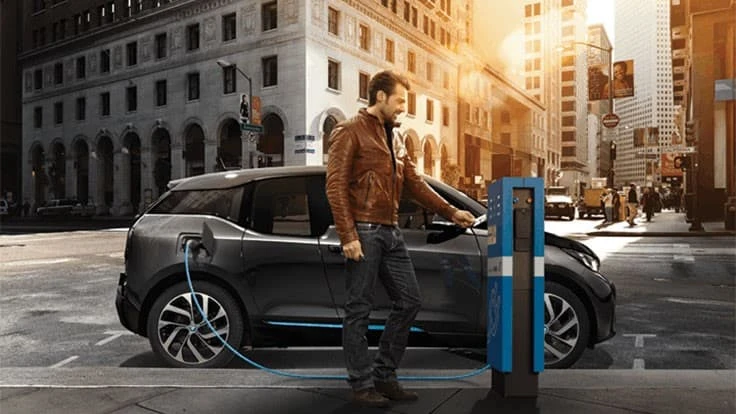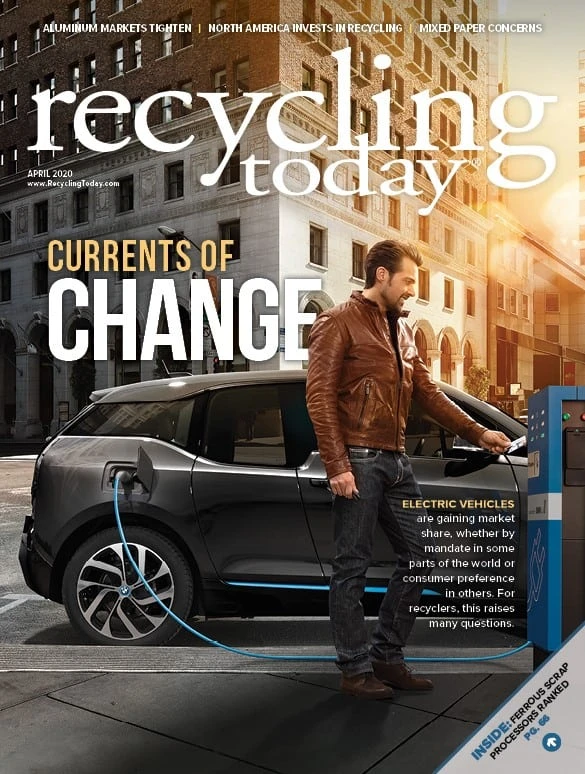
Photo courtesy of BMW

Since 2003 when Elon Musk established Tesla Inc., the South African-born, California-based entrepreneur has faced wide-ranging and enduring skepticism as to whether he could reach suitable levels of either mass production or profitability with his line of electric vehicles (EVs).
Musk and Tesla are perhaps just a global recession away from being a victim of turbulent waters, but Tesla demonstrated its ability to hit its own targets for vehicle production in 2019. The company also proclaimed two consecutive quarters of profitability last year.
The larger story since 2003, however, has been the emergence of EV models overall to compete with internal combustion engine (ICE) vehicles. Complicating things further for recyclers, EVs are now part of a wider range of alternative-fuel vehicles that in their early stages are spinning out a variety of battery, fuel cell and component types.
As of 2020, auto salvage and shredding companies are seldom encountering EVs and their alternative-fuel counterparts. However, these same recycling firms may be wise to not only keep an eye on EV sales figures but also put time and effort into research pertaining to the challenges and opportunities inherent in this emerging end-of-life vehicle (ELV) stream.
By the numbers
A fair starting point in preparing for an upcoming EV “revolution” could be to acknowledge that it may not be as inevitable as its fiercest advocates (and biggest investors) are claiming. This is especially true in the United States, where the federal government historically and as currently configured is far less likely to mandate such a sweeping change in a marketplace.
An April 2019 assessment by Washington-based Edison Electric Institute (EEI) showed the first quarter of last year displaying impressive growth for EV sales in the U.S.—but from a low base figure.
According to the EEI, EV sales in the first quarter of 2019 “increased 10 percent over Q1 2018 sales.” Even after that boost, however, the market share of EVs in the U.S. was just 1.8 percent in March 2019 and 1.5 percent for the quarter. “EV market share is growing but still represents a tiny fraction of all cars in the U.S.,” EEI writes.
The rest of 2019 was not so kind to the EV market in the U.S. “In 2019, sales of electric vehicles fell from about 360,000 to 330,000, despite the dramatic rise of Tesla Model 3 sales,” Electrek.co reported in January 2020.
The outlook for this year is uncertain, though consumers will have a wider choice of EV models in showrooms. A dozen or more new EV models are scheduled for the U.S. market in 2020, including entries from Audi, Honda, Mercedes, Volkswagen, Volvo and an electric-powered Ford Mustang.
Even with a little more choice, it seems unlikely EVs will capture more than a small single-digit market share in the early half of this decade. Many other nations are showing a similar pattern, though a few others present significant contrasts to the U.S. market.
At the other extreme is Norway, where EVs have captured 79 percent of market share, thanks in part to government incentives and affordable, abundant hydro-electric power. China built and sold nearly 1.2 million EVs in 2018, according to the EEI, with government incentive programs again playing a major role.
In the United Kingdom, February 2020 saw “plug-in EV sales jump by 117 percent year over year,” according to figures published by InsideEVs.com. The website adds, “As the overall number of new registrations went down by 2.9 percent to [fewer than 80,000], the market share for plug-ins grew to 5.74 percent,” or one out of every 17.4 new cars sold.
Incentives and targets are poised to play a bigger role in such sales increases in other parts of the world. In the U.S., though, such incentives have been more widely present in proposals rather than in enacted legislation.
Adding one more element of uncertainty is whether EVs, as currently designed, will even be the leading alternative- fuel vehicle by the end of this decade.
New battery configurations are introduced regularly within the alternative-fuel vehicle sector. Compressed natural gas (CNG) vehicles have made inroads in truck and fleet applications, and hydrogen-fueled vehicles continue to garner research dollars and supporters.
What the previous decade’s EV experience has helped accomplish is to open a window for recyclers into how ELV recycling might change in the future. Predicting when or if alternative fuel vehicles will assume a larger presence on highways remains murky. If they do, though, several years later it will affect auto salvage and shredding operations.
Win, lose or draw?
Some of the winners and losers in the ICE versus EV market share contest are relatively easy to identify. This is particularly true concerning catalytic converters and lead-acid batteries.
Neither of these two ICE vehicle components are required on EVs, but each represents a large ICE component manufacturing and recycling niche.
Converters (which contain high-value palladium or platinum), mufflers and exhaust pipes are not needed on EVs, which lack emissions. Some EVs do contain lead-acid batteries, as they remain a lower-cost option as a 12-volt provider of lighting, entertainment and heating and cooling functions. However, lead-acid batteries are heavier than lithium-ion or other types of batteries, and lightweighting research is focusing on replacements.
The lightweighting trend, already present in the ICE market, is of equal or greater importance in EV design. The drive to get more distance from an equivalent unit of power will continue to put pressure on metals producers in particular.
At times, this has benefited aluminum producers. Institute of Scrap Recycling Industries (ISRI) President Robin Wiener, in a 2020 article prepared for the Material Recycling Association of India (MRAI), writes that 2018 model vehicles contained 10.7 percent aluminum by weight, “more than double the amount in 1990, when the figure stood at 4.7 percent.”

The other lightweighting winner, less welcomed by auto dismantlers and shredder operators, has been plastic. Wiener writes that from 1990 to 2018, the weight of plastics used in the average U.S. passenger vehicle—like aluminum—also more than doubled.
While aluminum may hold its place in the EV market, this is not unanimously good news for all producers of the metal. In a 2018 article published by Recycling Today, Henry Van of London-based CRU described how the turn toward EVs in China had greatly affected that nation’s demand for aluminum castings—and the scrap used to produce them. (See the sidebar, “I cast you out,” above.)
The pressure on iron and steel producers has resulted in newly blended steel alloys, sometimes referred to as high-strength and ultra-high-strength steels. These alloys are winning occasional victories in the automotive market for steelmakers, but they also could cause additional sorting tasks for recyclers.

Metals contained in lithium-ion batteries, which currently predominate in the battery packs of Tesla and many other EVs, have enjoyed a demand boost from EV production.
That boost should assist with the pricing of nickel and cobalt, and perhaps for the demand of high-purity recycled nickel or cobalt. It is less clear, however, how auto dismantlers and shredder operators ultimately will tie into any profitable equation to recycle such end-of-life battery packs.
The wide variety of potential changes inherent in a switch from an ICE-dominated to an EV-dominated market is enough to concern established dismantlers and shredder operators.
In a 2019 interview with Recycling Today, Kenny Burgess of Kansas City, Missouri-based shredding plant operator Midwest Scrap Management referred to the proposed Green New Deal and its push toward EVs as potentially “being devastating to the scrap recycling industry if it is passed, as it will fundamentally change manufacturing and, in turn, recycling in the United States.”
He is far from alone in his concerns. As ISRI President Wiener states in her article, “One of the biggest challenges facing shredder operators and auto recyclers around the world is the growing number of hybrid and electric vehicles.”

Follow the money
Should auto dismantlers, shredder operators and metals producers be prepared for this vastly different future?
It can be hard to parse words from actions when corporations and investors address sustainability issues and express a desire to enact major change. Such statements can circulate at the global gathering in Davos, Switzerland, early each year, and in 2020 multibillion-dollar money manager BlackRock Inc. issued one such policy position.
Larry Fink, chairman and CEO of New York City-based BlackRock, writes in letters sent to his firm’s clients and global CEOs, “Our investment conviction is that sustainability- and climate-integrated portfolios can provide better risk-adjusted returns to investors.”
What follow-up by the $6 trillion investment fund manager will mean for electric versus ICE vehicles is unclear, but since Fink says future analysis will include assessments of the “physical climate risks” of each investment, that often connects to the use of fossil fuels.
Vitaliy Katsenelson, CEO of Colorado-based investment management firm IMA Inc., recently wrote a 37-page essay looking at Tesla and at the future prospects of EVs. He recounts his own experience in putting down a deposit on a Tesla 3 in 2015 and waiting in frustration for three years for delivery.
However, as of January, Katsenelson writes, “I can tell you one thing: Just as you cannot go back to a dumb phone once you get inoculated by a smartphone, I will not buy a gasoline car ever again. I drove my wife’s gasoline car (my pre-Tesla car) a few days ago, and I was shocked by how slow and unresponsive it was.”
Concerning the wider market, he predicts more consumers will connect with the simplicity and ease of maintenance he says are inherent in EVs—especially if recharging capacity expands.
If trip range and charging infrastructure concerns can be allayed, Katsenelson writes that consumers will find that “the complexity of the traditional ICE car is mind-boggling. There are several thousand moving parts that are interconnected by belts and gears and need to be constantly oiled and cooled. Air must be continuously pulled in to mix with gasoline to achieve combustion.”
He continues, “While the ICE engine is large, heavy and ‘internally combusts’ many times each second, the electric engine is exponentially simpler. It’s much lighter and smaller, and you can count the number of moving parts on your right hand. This removes a lot of complexity in car design.”
For auto dismantlers and shredder operators, however, that lack of complexity and “moving parts” is precisely what causes concern.
McKinsey & Co., in a 2017 report on EVs, uses the 2017 Nissan Leaf as an example of how EVs have simplified and lightweighted in ways that could severely impact auto components makers (and scrap generation) and the material that comes out of shredding a typical vehicle.
The newly introduced 2011 Nissan Leaf was a staggering 3,300 pounds lighter than comparable ICE passenger cars. The powertrain of the 2017 Leaf was about 44 pounds lighter and the body about 42 pounds lighter than the debut model.
Aluminum has been a favored material for EV makers, the McKinsey report authors write, especially in larger EV crossover and luxury vehicles being introduced. “In luxury EVs, aluminum accounts for about 40 percent of vehicle weight, mainly to boost acceleration and dynamic performance.”
Overall, however, producers of metal components—and eventually recyclers—will have to compete with a vastly different landscape if EV market share grows in North America.
Authors Mauro Erriquez, Thomas Morel, Pierre-Yves Moulière and Philip Schäfer of McKinsey conclude, “As demand rises, EV technology and design will continue to evolve, and strategic challenges will follow. Established OEMs (original equipment manufacturers) and their traditional suppliers will need to rethink their approaches to preserve their revenue and profitability.”
That same warning seems just as appropriate to scrap recyclers who serve those automakers and component producers, as well as to the dismantlers and shredding plant operators whose business model is intertwined with the cars and trucks on North American highways.
Get curated news on YOUR industry.
Enter your email to receive our newsletters.

Explore the April 2020 Issue
Check out more from this issue and find your next story to read.
Latest from Recycling Today
- Republic Services, Blue Polymers open Indianapolis recycling complex
- Altilium produces EV battery cells using recycled materials
- Brightmark enters subsidiaries of Indiana recycling facility into Chapter 11
- Freepoint Eco-Systems receives $50M loan for plastics recycling facility
- PET thermoform recycling the focus of new NAPCOR white paper
- Steel Dynamics cites favorable conditions in Q1
- Hydro starts up construction in Spain
- Green Cubes unveils forklift battery line





